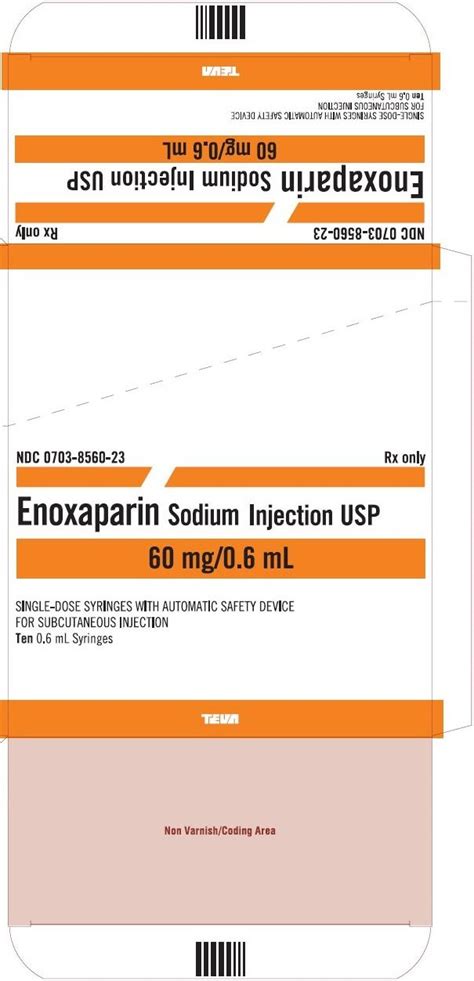Intro
Inj Enoxaparin Sodium is a crucial medication in the field of medicine, particularly in the prevention and treatment of thromboembolic disorders. The importance of this medication cannot be overstated, as it has been proven to be effective in reducing the risk of deep vein thrombosis (DVT) and pulmonary embolism (PE) in patients undergoing surgical procedures or suffering from certain medical conditions. With its widespread use, it is essential to delve into the details of Inj Enoxaparin Sodium, exploring its benefits, working mechanisms, and practical applications.
The significance of Inj Enoxaparin Sodium lies in its ability to prevent the formation of blood clots, which can be life-threatening if left untreated. Blood clots can occur in the deep veins of the legs, known as deep vein thrombosis, and can break loose, traveling to the lungs, resulting in a pulmonary embolism. Inj Enoxaparin Sodium works by inhibiting the coagulation process, thereby reducing the risk of blood clot formation. This medication has been extensively used in various medical settings, including hospitals, clinics, and even at home, under the guidance of a healthcare professional.
The use of Inj Enoxaparin Sodium has been associated with several benefits, including its ease of administration, effectiveness in preventing blood clots, and relatively low risk of side effects. Patients who have undergone surgery, particularly those with a high risk of developing blood clots, have greatly benefited from this medication. Additionally, Inj Enoxaparin Sodium has been used to treat patients with acute coronary syndrome, including those with unstable angina or non-ST-segment elevation myocardial infarction.
Introduction to Inj Enoxaparin Sodium

Benefits of Inj Enoxaparin Sodium
The benefits of Inj Enoxaparin Sodium are numerous, including: * Reduced risk of deep vein thrombosis and pulmonary embolism * Effective in preventing blood clots in patients undergoing surgical procedures * Relatively low risk of side effects, such as bleeding * Easy to administer, with a simple subcutaneous injection * Can be used in a variety of medical settings, including hospitals, clinics, and at homeWorking Mechanism of Inj Enoxaparin Sodium

Steps Involved in the Working Mechanism
The steps involved in the working mechanism of Inj Enoxaparin Sodium include: 1. Binding to antithrombin: Inj Enoxaparin Sodium binds to antithrombin, a protein that inhibits the coagulation process. 2. Inhibition of factor Xa: The medication inhibits the activation of factor Xa, which is essential for the coagulation process. 3. Inhibition of thrombin: Inj Enoxaparin Sodium also inhibits the activation of thrombin, which is essential for the coagulation process. 4. Prevention of blood clot formation: The inhibition of the coagulation process prevents the formation of blood clots, thereby reducing the risk of deep vein thrombosis and pulmonary embolism.Practical Applications of Inj Enoxaparin Sodium

Examples of Practical Applications
Examples of practical applications of Inj Enoxaparin Sodium include: * A patient undergoing hip replacement surgery may be given Inj Enoxaparin Sodium to prevent deep vein thrombosis and pulmonary embolism. * A patient with acute coronary syndrome may be given Inj Enoxaparin Sodium to prevent blood clots and reduce the risk of further cardiac events. * A patient with a high risk of developing thromboembolic disorders may be given Inj Enoxaparin Sodium to prevent blood clots and reduce the risk of deep vein thrombosis and pulmonary embolism.Side Effects of Inj Enoxaparin Sodium

Management of Side Effects
The management of side effects of Inj Enoxaparin Sodium includes: * Monitoring for bleeding: Patients taking Inj Enoxaparin Sodium should be monitored for signs of bleeding, such as bruising, bleeding gums, and nosebleeds. * Managing injection site reactions: Injection site reactions can be managed by applying a cold compress to the affected area and taking pain relief medication. * Treating allergic reactions: Allergic reactions should be treated promptly, with antihistamines and corticosteroids, and the patient should be monitored for signs of anaphylaxis.Conclusion and Future Directions

What is Inj Enoxaparin Sodium used for?
+Inj Enoxaparin Sodium is used to prevent deep vein thrombosis and pulmonary embolism in patients undergoing surgical procedures, as well as to treat acute coronary syndrome.
How is Inj Enoxaparin Sodium administered?
+Inj Enoxaparin Sodium is administered subcutaneously, typically in the abdominal area, and is usually given once or twice daily, depending on the patient's condition and the doctor's prescription.
What are the side effects of Inj Enoxaparin Sodium?
+The side effects of Inj Enoxaparin Sodium include bleeding, injection site reactions, and allergic reactions.
We hope this article has provided you with a comprehensive understanding of Inj Enoxaparin Sodium, its benefits, working mechanisms, and practical applications. If you have any further questions or would like to share your experiences with Inj Enoxaparin Sodium, please do not hesitate to comment below. Additionally, if you found this article informative, please share it with others who may benefit from this information.
